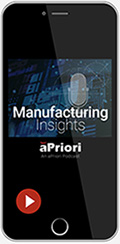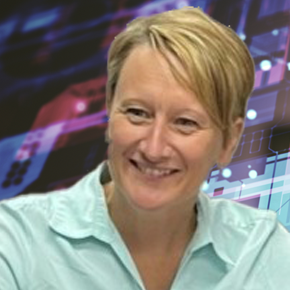February 7, 2023
Digitization Cuts Product Development Times from Months to Hours

Transcript
There are a lot of reasons you want to speed up product development through digitization. Competition is fierce, and it’s global. You can no longer count on cheap labor or affordable materials to fill out your margins. So if you want to grow and compete, you’ve got to get products to market sooner in a way that meets immediate needs. The key to doing this is automating the product design process. And that takes digitizing product development.
This is the bugbear of Uyiosa Abusomwan, Professor of Product Management and Industry 4.0, part of the Masters of Engineering Management and Leadership program at Rice University. Uyiosa Abusomwan is an innovative leader at Eaton Corporation, where he and his team are revolutionizing the way Eaton develops products. They’ve done this digitizing their product data and engineering models. Doing this, his team has streamlined product design so much so that a process that used to take months now takes hours.
Uyiosa Abusomwan, welcome to the podcast.
Uyiosa Abusomwan: Thank you, Leah. It’s a pleasure to be here.
How Can You Shorten a Product Development Cycle from Months to Hours?
Leah Archibald: So tell me, a product development cycle that used to take you several months, now takes you hours. How is this even possible?
Uyiosa Abusomwan: The short answer to how to shorten the product development cycle is automation of design processes. Typically, if we look at the traditional product development process, we have people in New York sending models and files and requirements to someone else in the West Coast, and that data could go to China for manufacturing, or it could go to India for additional engineering work and so on. So the idea is: How can we effectively automate the design process – the ands-off of requirements and models and data – and streamline the process to expedite the design of the product.
What is Automation in Product Development?
Leah Archibald: Tell me more about automation in product development. Because we often think of product development as very people-heavy.
Uyiosa Abusomwan: Automation in product development involves two kinds of digitization. The first is digitizing the domain knowledge. The second is digitizing the design processes.
Two Steps to Automation in Product Development
Uyiosa Abusomwan: The first step is to digitize the knowledge that it takes to create a new product. We need to digitize domain knowledge so that a machine can read it. For example: I’m designing a valve, and I need to find an O-ring that is suitable for that valve. Can we have a machine read a table and pick that? Can we digitize that knowledge in such a way that a computer can assign an O-ring profile and select an O-ring for our product? That’s step 1, digitizing domain knowledge.
Step 2 is digitalizing processes. For example, when we do design, we create a CAD model, we create engineering calculations, we create models for cost using aPriori. Can we parameterize the design variables? Can we set up those models in such a way that a machine can execute those files? For example, with aPriori, we run aPriori in batch command mode and feed in the parameters that we need to do the job. That’s digitalizing the processes: setting them up in such a way that a computer can execute those models, can pull outputs out of them, can push inputs into them and effectively drive the work that humans do.
Leah Archibald: This sounds like a completely different workflow from what engineers are used to in product design. Could you just give me an idea of what it looks like? Like if I’m sitting behind an engineer’s shoulder, and I’m looking at their computer, how is it different?
Uyiosa Abusomwan: That is a very good question. Before digitalization, when designers were working, they were not taking into consideration the possible variation of that design. They were not taking into consideration the potential for a computer to change the geometries in the design or change the material in the design. For a long time, CAD modeling software has been parametric.
What is Parametric Design?
Leah Archibald: Define what does parametric mean in terms of CAD software?
Abusomwan: Modeling software has been parametric in the sense that a computer can change the parameters. So for example you have a shaft, you will have a diameter, and you have an overall length. And before now, when engineers built a shaft, they just say, “Overall length, 10 inches, diameter, 2 inches.” And that’s all they care about. The software itself assigns a parameter to that length and assigns a parameter to that diameter, and those are not exposed.
But moving forward now, a designer now has to say, “I have to assign a parameter now, a parameter to the length and a parameter to the diameter such that a computer can override the diameter that I set it to be.” For example, I can say, “My length is L, and it’s equal to 10.” In the future, a human can come in and change L equal to 15. A computer program can also change L and change L equal to 8. So that is what parameterization is all about, it’s setting up our models in such a way that a computer can change the material properties and other variables in our product.
Digitization Drives Automation, Drives Innovation, Drives Business Results
Leah Archibald: And what is the benefit of allowing a computer to do that? What does it get you in the end?
Uyiosa Abusomwan: That’s what drives this automation. Humans, using our creativity, come up with the architecture. A computer can take that architecture and drive optimization. So, I am designing a shaft, and I need to optimize that shaft for given load conditions. A computer can take that and very quickly change the length to meet a designed goal, or a desired goal, or the design requirement that we get from our vendors.
The value here is by parameterizing our engineering models, by digitizing our domain knowledge, we can allow a computer to do the iterative work that we would have done as humans. This could be a product with thousands of design parameters that drives the performance of that product. By enabling machines to do this iterative work, the machine can go way beyond our capabilities as humans and explore the design space to a point where it can find an optimal solution. A human, even a technical expert, cannot come up with that.
Leah Archibald: That’s really what you need in this competitive market. You need to maximize the resources that you have of labor. Design engineers are in short supply. So you need the labor that you have to be making shrewd decisions that only humans can make. And then you need to be automating everything else that can be automated, so that the innovation can come from the people, but the product development time can shrink down to the absolute minimum it needs to be to get a new innovative product to market.
Uyiosa Abusomwan: Talking about shrinking time, traditionally just getting the requirement from the field to the engineering team may take a week. And then the project gets assigned to someone, and it may take another five days before they get to it. Then they create some initial design, a draft, and send that over to a simulation team. It may take another week before the simulation team gets to the work, and to run the simulation they have to set up the simulation process from scratch, bring in the model, assign loads and boundary conditions and so on. They come back with a result, and you refine the design. Maybe you do one more or two more iterations, and you have a final simulation report, you have your CAD file, you push into a drawing, you do a DFM checklist, and all those things. By the time you’re done, you’re really thinking about an engineering cycle of months. However, if you digitized your processes and set it up on a platform, the requirements can get to that platform pretty much in minutes. And the engineering manager can sit in front of that platform and put in the requirement right away instead of sending an email or putting in a ticket. Immediately they hit Execute, and the process I just explained starts. The computer runs the process, creates the CAD model, does the optimization and pushes out the result. At most, you’re thinking days, and in a minimum – from what we’ve seen – it’s really minutes to hours.
Leah Archibald: Uyiosa Abusomwan, thank you so much for joining me on the podcast today.
Uyiosa Abusomwan: It’s a pleasure, Leah. Thank you for having me.







